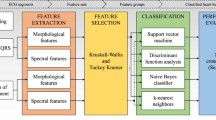Abstract
A two-stage ventricular beat ‘associative’ classification procedure is described. The first stage separates typical beats from extrasystoles on the basis of area and polarity rules. At the second stage, the extrasystoles are classified in self-organised cluster formations of adjacent shape parameter values. This approach avoids the use of threshold values for discrimination between ectopic beats of different shapes, which could be critical in borderline cases. A pattern shape feature conventionally called a ‘fractal number’, in combination with a polarity attribute, was found to be a good criterion for waveform evaluation. An additional advantage of this pattern classification method is its good computational efficiency, which affords the opportunity to implement it in real-time systems.
Similar content being viewed by others
References
Barro, S., Ruiz, R. andMira, J. (1990) Fuzzy beat labeling for intelligent arrhythmia monitoring.Comput. Biomed. Res.,23, 240–258.
Forster, C. andHandwerker, H. O. (1990) Automatic classification and analysis of microneurographic spike data using a PC/AT.J. Neurosci. Meth.,31, 109–118.
Friesen, G. M., Jannet, T. C., Jadallah, M. A., Yates, S. L., Quint, S. R. andNagle, H. T. (1990) A comparison of the noise sensitivity of nine QRS detection algorithms.IEEE Trans.,BME-37, 85–98.
Gelsema, E. S., Bao, H. F., Smeulders, A. W. M. andHarink, H. G. (1988) Application of the method of multiple thresholding to white blood cell classification.Comput. Biol. & Med.,18, 65–74.
Goldberger, A. L. (1987) Fractals in physics and medicine.Yale J. Biol. Med.,60, 421–435.
Katz, M. J. (1988) Fractals and the analysis of waveforms.Comput. Biol. & Med.,18, 145–156.
Kohn, A. F. (1989) Fractal number and spectral skewness: two features for the pattern classification of motor unit action potentials. Proc. 11th Annual Int. Conf. IEEE Eng. in Med. & Biol. Soc., Seattle, Washington, 8th–12th Nov.
Lanza, G. A., Lucente, M., Rebuzzi, A. G., Cortellessa, M. C., Tamburi, S., Mancuso, P., Neri, R. andManzoli, U. (1990) Accuracy in clinical arrhythmia detection of a real-time Holter system (Oxford Medilog 4500).J. Electrocardiol.,23, 301–306.
Lin, D., Dicarlo, L. andJenkins, J. (1988) Identification of ventricular tachycardia using morphologic analysis of the intraventricular electrogram (abstract). —Ibid.,21, S120.
Lin, K. P. andChang, W. H. (1989) QRS feature extraction using linear prediction.IEEE Trans.,BME-36, 1050–1055.
Lowery, M., De Marchena, E. J., Castellanos, A., Myerburg, R. J. andKessler, K. M. (1990) Interrelationship of variable coupling, multiformity and repetitive forms: Implications for classification of ventricular arrhythmias.Am. Heart J.,119, 301–307.
Mandelbrot, B. R. (1983)The fractal geometry of nature. W. H. Freeman & Co., New York, USA.
Merri, M., Benhorin, J., Alberti, M., Locati, E. andMoss, A. J. (1989) Electrocardiographic quantification of ventricular repolarization.Circ.,80, 1301–1308.
Pahlm, O. andSörnmo, L. (1984) Software QRS detection in ambulatory monitoring—a review.Med. & Biol. Eng. & Comput.,22, 289–297.
Paparella, N., Alboni, P., Cappato, R., Pirani, R., Gruppillo, P., Preziosi, S., Battaglia, R., Corio, R., Occari, G., Berti, C. andSapigni, T. (1987) Prominent anterior QRS forces: clinical, electrocardiographic and prospective study.J. Electrocardiol.,20, 233–240.
Salerno, D. M., Granrud, G. andHodges, M. (1987) Accuracy of commercial 24-hour electrocardiogram analyzers for quantitation of total repetitive ventricular arrhythmias.Am. J. Cardiol.,60, 1299–1305.
Sörnmo, L., Börjesson, P. O., Nygards, M. andPahlm, O. (1981) A method of evaluating QRS shapes features using a mathematical model for the ECG.IEEE Trans.,BME-28, 713–717.
Wolberg, W. H. andMangasarian, O. L. (1990) Multisurface method of pattern separation for medical diagnosis applied to breast cytology.Proc. Nat. Acad. Sci. USA,87, 9193–9196.
Author information
Authors and Affiliations
Rights and permissions
About this article
Cite this article
Bakardjian, H. Ventricular beat classifier using fractal number clustering. Med. Biol. Eng. Comput. 30, 495–502 (1992). https://doi.org/10.1007/BF02457828
Received:
Accepted:
Issue Date:
DOI: https://doi.org/10.1007/BF02457828




